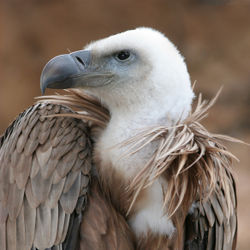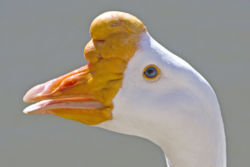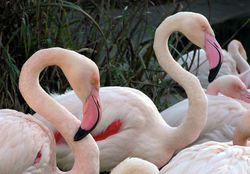
The bill of a scavenger—the
vulture.
|

The bill and knob of a
Swan Goose.
|

Northern Gannets billing.
|

The bill of the Greater Flamingo
|
The beak—otherwise known as the bill or
rostrum—is an external anatomical structure which serves
as the mouth in some animals. It is a distinctive feature of
birds and, in addition to eating, is used by them for
grooming, manipulating objects, killing prey, probing for
food, courtship, and feeding their young.
Anatomy
Beaks can vary significantly in size and shape from
species to species. The beak is composed of an upper jaw
called the
maxilla, and a lower jaw called the mandible. The jaw is
made of bone, typically hollow or porous to conserve weight
for flying. The outside surface of the beak is covered by a
thin horny sheath of keratin called the rhamphotheca. Between the hard
outer layer and the bone is a vascular layer containing
blood vessels and nerve endings. The rhamphotheca also
includes the knob which is found above the beak of
some swans, such as the
Mute Swan and some Swan Geese (pictured).
The beak has two holes called nares which connect
to the hollow inner beak and thence to the respiratory
system. In some birds, these are located in a fleshy, often
waxy structure at the base of the beak called the cere
(from
Latin cera. Hawks, parrots,
doves, and
skuas are among the birds that have ceres. Budgerigars are
dimorphic because the males' ceres turn bright blue upon
maturity, while the females' ceres turn tan. The female
budgies' ceres also appear wrinkled, to a greater extent
during periods of fertility. Immature budgies have pale
pinkish ceres which are smooth and shiny.
Nares are bird
nostrils. The nares of birds are usually located
directly above the beak.
On some birds, such as the
budgerigar, the nares are situated within the cere.
Nares can also refer to nostrils on other animals, such
as sharks, rays, and sawfishes. Nares is a medical term from Latin that
describes human nostrils.
On some birds, the tip of the beak is hard, dead tissue
used for heavy-duty tasks such as cracking nuts or killing
prey. On other birds, such as ducks, the tip of the bill is
sensitive and contains nerves, for locating things by touch.
The beak is worn down by use, so it grows continuously
throughout the bird's life.
Unlike jaws with teeth, beaks are not used for chewing.
Birds swallow their food whole, which is broken up in the
gizzard.
Examples of birds with unusual beaks include the
hummingbird, the
toucan and the spoonbill.
Billing
During courtship, mated pairs of a variety of bird
species touch and clasp each other's bills. This is called
billing, and appears to strengthen the
pair bond (Terres, 1980).
Gannets raise their bills high and repeatedly clatter
them (pictured); the male
puffin nibbles at the female's beak; the male
waxwing puts his bill in the female's mouth; and
ravens hold each other's beaks in a prolonged "kiss".
See also
References
- Gilbertson, Lance; Zoology Lab Manual; McGraw
Hill Companies, New York;
ISBN 0-07-237716-X (fourth edition, 1999)
- Terres, John. K. The Audubon Society Encyclopedia
of North American Birds, New York: Alfred A. Knopf,
1980.
ISBN 0394466519
External links




